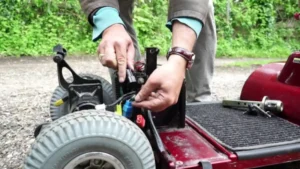Care for SLA or lithium batteries properly will ensure a more seamless experience and extend their lifespan. Here are some helpful tips.
Batteries can degrade over time, which is hastened by extreme temperatures. To keep batteries functioning at their best, store them in cool, dry locations while fully charging them before storage.
Chargers
Mobility scooters typically use sealed lead acid batteries. While they are durable and long-lived, like all batteries they will eventually wear down and need replacing.
To prolong its life and ensure optimal battery health, make sure that proper charging practices are utilized, storage in cool, dry environments is ensured, connections are clean and tightened regularly while using desulfators technology regularly for optimal health of battery.
Use the charger that came with your battery for safest and most efficient charging. This charger was often used during its initial testing phase so should provide optimal results for your battery. Furthermore, charging your battery daily or every other day if you plan on frequent use will prevent its cells from depleted too quickly and damage occurring to them.
Overheating can be one of the biggest threats to battery health. Any sign of overheating such as pungent or foul odor, smoke or fire should prompt immediate disconnection of charger and allow battery time to cool down before disposing of for safety considerations. If it still shows signs of life after this has taken place it should be immediately disposed of due to possible damages and be destroyed for safety purposes.
Overheating
Mobility scooter batteries play a pivotal role in their performance and longevity, yet many factors may compromise them, including overheating. Therefore, it is crucial to regularly inspect your battery as well as follow manufacturer’s recommendations regarding charging, storage and environmental concerns.
Overheating may result from overcharging or extreme temperature conditions, both of which can significantly decrease battery lifespan and performance of mobility scooter batteries. To help mitigate this risk, regularly check battery connections for looseness or dirt accumulation – tightening these as necessary or using water mixed with baking soda can prevent issues altogether.
Mobility scooter batteries naturally produce heat during use and charging due to inefficiency in energy transfer processes, leading to some heat creation. If your mobility scooter becomes uncomfortable hot to the touch or emits an unpleasant odour then this could indicate overheating that must be addressed immediately.
Problems with your mobility scooter’s motor are also often to blame, serving as the engine that distributes and moves power around. Motor issues may lead to sudden stops, particularly if there are problems with its braking system which relies on friction for slowing it down.
Overcharging
An effective charging routine for mobility scooter batteries is vitally important to their health and longevity. Failing to charge at a regular level could result in deep discharge, which will severely shorten their lifespan. For maximum longevity it is advised that batteries be charged when their gauge indicates low power – every week if being regularly used – while also keeping temperatures cool and dry in storage facilities.
Relying on charging your scooter every day can cause its battery to suffer sulfation and reduce both its lifespan and capacity. For optimal battery health, unplug it after eight hours of charging and only plug it back in just before using your mobility scooter – also consider using a timer or another method to monitor charging cycles to avoid overcharging!
Make sure that you use only the charger provided by the manufacturer and ensure it matches the voltage of the battery for best results, as using one with higher voltage may cause overheating. Incompatible chargers could damage batteries as well as create fire risks – for more advice regarding compatibility of your battery contact a mobility scooter technician or manufacturer for guidance.
Discharging
Although rare, batteries can occasionally catch fire due to damage or incorrect charging procedures. Lithium-ion batteries pose the greatest fire hazard and should always be charged in an open, cool location away from any potential flammable materials or heat sources. Mobility scooter batteries should always be charged safely.
No matter if your mobility scooter is leased through Motability Scheme or purchased outright, following proper charging protocols to preserve and extend battery health is vital to its health and lifespan. In general, batteries should be charged every night until their indicator indicates full charging status; this prevents overcharging while prolonging performance over time.
Regular inspections should be conducted to inspect your battery and its connections for signs of damage, swelling or corrosion. If any concerns arise, professional help should be sought immediately to avoid irreparable harm to the system.
Battery maintenance is also key if you plan on taking your mobility scooter on vacation, especially if it will be stored for an extended period. Regularly charging its battery to prevent its level from becoming too low and suffering a deep discharge is imperative, as is regularly cleaning connections using baking soda and water solutions to prevent build-up that may result in voltage drops.




